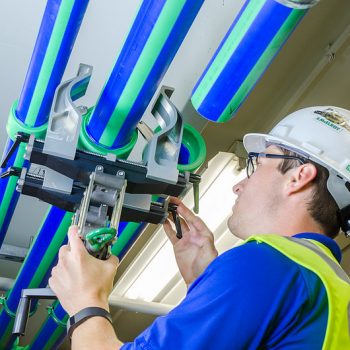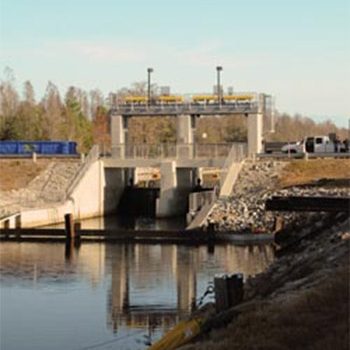
FUSION IS BORN
It was after 5 p.m. and Art McElroy was still in his office with two engineers from Phillips DriscoPipe whom he knew from a prior job. One of them mentioned that their fusion machine supplier had opted not to develop one of their ideas on making a better-equipped machine for their high-density polyethylene (PE) pipe product. Would McElroy be interested in making a prototype machine?
Art whipped out his yellow pad and black felt-tip pen and asked … what is it supposed to look like? What is it supposed to do?
And that’s how this contract job shop and fintube machine manufacturer got into the fusion business. It was the fall of 1969 — the year man took one small step on the moon and McElroy took a giant leap into a world of endless possibilities.
The first fusion prototype was a small, 2-inch machine. Art took it to Phillips in Bartlesville and said that if they were interested, he would like to redesign it to balance the forces, which became the patented Centerline Guidance System, a cornerstone feature of all McElroy fusion equipment today. Phillips was convinced Art should go ahead with his own design. It was better. Art did just that and Phillips turned around and sold 25 them along with their gas pipe and fittings to Kansas Gas Service.
David Dutton, a Salesman at the time, recalls Art saying that there’s nearly always a weak point on any new project, something that keeps you from being successful. But PE pipe was different. He didn’t see any weak links. He didn’t see any stumbling blocks — he saw a future. He thought it could be a real industry.
“I think he was the first to recognize this was more than a job shop deal,” David said.
When Phillips began to receive calls about fusion machine maintenance and parts, it was decided that McElroy would sell its machines direct and Phillips would focus on what they did best — pipe and fittings. Together, they would work the natural gas industry and see if they could make something out of this PE business. They were off to the races.
The first machine that launched the business was a 4″ Hand Pump and more sizes developed rapidly after that. There were stationary machines, then wheeled models and eventually tracked vehicles. Many tried to replicate McElroy’s equipment over the years, but McElroy wouldn’t make it easy. Art’s philosophy was to stay ahead of the game by investing in engineering and product development and the business flourished as a result — McElroy become the leading innovator of pipe fusion equipment.

ON THE ROAD
Before there were distributors, there were three big white vans. McElroy packed them with machines up to 28″ and parked them at airports in the east, Midwest and west coast. David, Ted Striplin and Lee Dester were some of the first salesmen. Their job was to fly to the vans, fire up the engines and hit the road with their wares. They gave demos, trained customers, rented machines, sold parts, made repairs and logged a lot of miles. PE became the material of choice for gas distribution, and McElroy, with a lot of guts, grit and glory, eventually became the preferred equipment.

DISTRIBUTION & TRAINING
Being committed to the industry on every level, Art dreamed of having a formal training facility. McElroy University was established in 1981 to ensure that operators and inspectors develop best fusion practices. It was also around this time that Art recognized McElroy needed distributors to help sell equipment on a broader scale. It no longer made sense to send salespeople all over the country selling one type of product. It was a natural progression because the market was already established for McElroy machines and, unlike its competitors, fusion was a major part of McElroy’s business and a lot of time and effort had been devoted to it. McElroy’s people had become experts at handling the machines. They talked the same talk and their training was consistent. Another ace in the deck was butt fusion capability and the force advantage McElroy machines imposed over companies that were hand- and socket-fusing a lot of their pipe at the time.
The first distributors were hired in 1984. Among them were Consolidated Pipe & Supply, UPSCO and Groebner. Today, there are distributors — ISCO being the largest — in every state in the nation and a growing network of international distributors.

THE SIGNATURE LINE
In the early 90s, customers in the mining industry asked if McElroy had considered making fusion machines self-propelled. Chip McElroy said they had looked at putting motors on the wheeled machines but there wasn’t great traction. It was around that time that he along with Dave Tanner, who managed the McElroy Fluid Power division, and Jim Perrault, who managed Research and Development, attended the EIMA International Expo in Bologna, Italy, where they were struck by the mobile equipment with rubber tracks. Chip sketched a concept for a track-mounted fusion machine on a napkin and began to develop the idea, but there were a lot of questions about how they would package it, the size and the cost.
“There was enough doubt that I decided to turn it into a skunk works project,” Chip said.
Undeterred and energized at the thought of creating a more job-friendly line of equipment, Chip designed a cardboard model which eventually progressed to a prototype self-propelled, self-contained, track-mounted 500mm machine. In 1997, he along with Bob Biffle, a Technical Service Specialist, and Dave Porter, Project Manager in Engineering, demonstrated it at a distributor show in Tucson, Ariz., where it was a big success. Then they put it to the test on rugged terrain at the Phelps Dodge mine in Morenci, Ariz., one of the largest copper mines in the world, to see how it would perform. You might say it was impressive.
“That was the beginning of the TracStar,” Bob said. “Chip came up with the track design and it was actually better because it acted like a crawler or a Caterpillar. We were excited and all the people at the mine were excited, in fact they bought several machines.”
The TracStar is now the flagship of the machine line with a full range of tracked machines from 28″ up to 48″ OD. Users then and now love the mobility, hydraulic assistance on key functions and the fact that they require less manpower and allow them to be more productive.
“I think what they really have delivered is they have made our one machine/one operator concept of butt fusion more affective,” Chip said. “It sets us apart from the competition.”

TURNING FUSION UPSIDE DOWN
McElroy seeks input from users in the field in a constant effort to improve and help make their work easier and more productive. There’s always a goal on the horizon the company aims to meet, and something very big on the horizon came to fruition in 2013. It was sparked by the increasing use of pipe up to 2000mm. But the bigger the pipe, the higher a tracked-machine stands from the ground which can be an issue when loading big, heavy pipe up and over into a machine.
“That started us on a path in 2011 of looking into turning the machine upside down and gathering pipe into the machine to minimize material handling equipment on the job and reduce the potential risk to the operator and the machine,” Chip said. “We’re still optimizing the design to make it even more effective than the early jobs have already proven.”
The groundbreaking Talon ™ 2000 is a self-propelled machine with an innovative jaw design that self-loads pipe from the ground, positions it to be fused and moves from joint to joint down the pipeline. The new method for handling pipe known as pipelining has revolutionized the way large-pipe is fused, making it much safer and more efficient.

IN THE BUILDING WITH POLYPROPYLENE
While Europe has been using fusible polypropylene-random pipe for years, the US didn’t begin to embrace it until recent years when a German company known as Aquatherm planted a flag in the US. McElroy recognized it as the ideal replacement for traditional piping products in commercial and industrial buildings and saw it as a great opportunity to bring its expertise in PE pipe fusion to the polypropylene (PP) world.
Dave Tanner began the task of starting a PP department for McElroy in April 2013. The fusion concept would be the same but the equipment would have to be redesigned to work efficiently inside buildings with space and weight considerations in mind. McElroy has since blazed new trails in innovative indoor fusion solutions for overhead and tight spaces. By 2018, the company offered socket tools as small as 16mm and butt fusion machines up to 630mm for polypropylene pipe — quite an accomplishment in five years!
The first product launched was the lightweight, Spider ™ 125 for socket fusion, which is by far the best-selling PP machine by quantity. Then came the start of the Acrobat ™ line for butt fusions, the SmartFab ™ 125 prefabrication machine, the Hornet ™ for outlet fusions, the Polygon ™ for miter fusion in zero- to 45-degree angles and our amazing jaw dropper, the Acrobat with QuikFit® carriage.
The QuikFit carriage was McElroy’s solution for fusing large pipe indoors safely and efficiently. It’s difficult to place an entire carriage in a tight space overhead, so McElroy created a modular, jaw design that allows users to assemble the carriage around the pipe by hand — a true revolution for the HVAC/Mechanical/Plumbing industry.
“It will take time, but I really believe PP will be bigger than PE one day,” Dave said. “There’s not one negative when you compare it to all the metals and PVC. It’s a leak-proof system that doesn’t rust and you can use maintenance dollars for other things inside your building. It’s all good.”
A FUTURE
McElroy succeeded in gaining a stronghold in natural gas distribution after making that critical decision to make fusion equipment 50 years ago.
“If you look at the industries that have already embraced this technology, they believe in it,” Chip said. “Those people are already believers and are challenging us to make our equipment more efficient, even easier to operate and to create the tools that let pipeline owners know joints were done per specification.”
Today, thermoplastics are gaining ground in nearly every industry, as heat-fused, leak-free joints are accepted as a reliable piping solution. There’s still a long way to go, but it’s still early in the journey and Art’s gut feelings about fusion are no less true today than they were 50 years ago. There’s a real future in fusion.


One comment on “50 Years of Fusion”
Comments are closed.